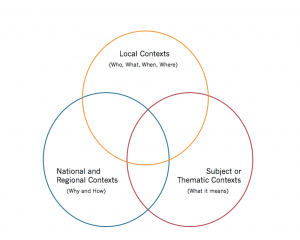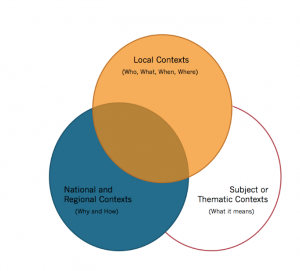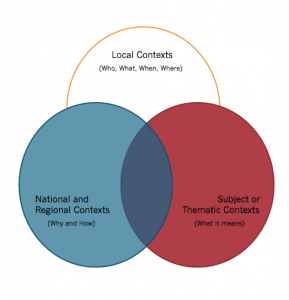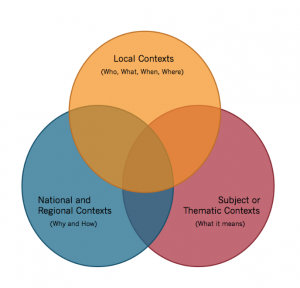Estimated time to complete this section: 3 hours
The significance of local history primary sources and the information they contain goes beyond what can be identified through analysis of the kind explored in Module 3. They also need to be understood within a broader historical context. It may be useful to think of context in three parts:
- Local contexts (Who, What, When, Where) describe the people, events, and time under investigation. When we consider local contexts, we answer questions about the specific places, social structures, and other circumstances that appear in our primary sources. Identifying these features is an important step toward connecting them to other local trends or events:
- Questions to consider:
- What happened?
- Who was involved?
- Where and when did it happen?
- How does this relate to other events/figures?
- How do we know that something happened?
- How does this person, event, or idea relate to local institutional themes, such as: leadership/government/local politics, place/space/location, labor/industry/employment, health/hospitals/institutions, education/institutions, transportation/technology/mass media, settlement/housing/community planning.
- Questions to consider:
- Regional or national contexts (Why and How) offer insights into broader historical themes or patterns. As we explore regional or national contexts, we ask larger questions about the subject under investigation. These questions can draw connections between local events and relevant social trends or movements from that time period, helping you to answer questions about why or how something occurred. They can also help complicate common, dominant narratives of local events.
- Questions to consider:
- Why or how did something happen?
- How does your topic appear in other places – regions nearby to your focus, other places in the US, other places in the world? How different is your story from what happened in other places? Consider what these comparisons reveal information about why or how the topic you are investigating occurred.
- What other historical events or subjects are taking place during your period of study? Think about your research question in terms of broader historical periods, for instance: Colonial America; Reconstruction; the Gilded Age; the Great Depression; the Cold War; the Civil Rights Movements. Consider how your research topic fits within those broader events – how did those events affect and reflect your topic?
- Questions to consider:
- Subject or thematic contexts (What it means) connect people and events to broader areas of historical inquiry. Take the New York Shirtwaist Strike of 1909. We can evaluate it through the lens of women’s history as well as labor history. Both of these areas of study offer connections to other historical events, and frameworks for further analysis.
- Questions to consider:
- To which broad themes does your topic connect? For instance: industrialization, immigration, urbanization or colonization; the experiences and identity of a particular group (African Americans, Asian Americans, Hispanic and Latino Americans, Indigenous Peoples); Disability; Gender; Religion; Children and Family; Culture; Science and Technology, Military.
- Consider how your research topic fits within those broader themes — which issues and trends affect and reflect your topic?
- What types of language, concepts or frameworks do historians use to describe and discuss these themes? Which seem relevant to your research topic?
- How do these subjects or themes change from one time period to another? How does your topic fit with those changes?
- Questions to consider:
Each of these types of context should be combined with the others to make sense of the events and figures of the past. If we use only one form of context to study history, we fall short of answering important questions about the people and events we study.
Similarly if we combine two types of context, Local and National/Regional Contexts, for instance, we run the risk of overlooking connections between local histories and larger social trends.
If we combine National/Regional Contexts with Subject or Thematic Contexts, we lose our connection with the people and places under consideration.
If we combine Local Context with Subject or Thematic Contexts, we run the risk of overlooking the ways in which people and events relate to structural or institutional shifts, or social movements and trends taking place more broadly.
Studies of history that combine all three forms of context offer a more complete understanding of the people and events under consideration.
Activity 4.1: Develop a list of contexts to explore
To which local, regional/national, and thematic contexts do your primary sources connect?
1. Using the questions to consider in the discussion of context on this page, create a list of questions related to your project for each level of context (local, regional/nation, subject/thematic).




